Georgia O’Keeffe’s artistry is a beacon in the realm of American modernism, her canvases a testament to an extraordinary engagement with the natural world. This article explores the essence of O’Keeffe’s work, from her early inspirations to her profound legacy, shedding light on how her unique vision transformed American art. Through examining key aspects of her career and artistic achievements, we gain insight into the depth and breadth of O’Keeffe’s influence in shaping modernist expression.
Early Life and Inspirations
In the landscape of American art, few figures loom as largely and as distinctively as Georgia O’Keeffe. Known for her pioneering approach to modernism and her evocative renderings of flowers, landscapes, and skulls that blend the abstract with the real, O’Keeffe’s artistic journey began in the verdant expanses of the Midwest. Born in 1887 in Sun Prairie, Wisconsin, the second of seven children, O’Keeffe’s early life was steeped in the rhythms of the natural world—an influence that would permeate her work throughout her career.
The genesis of O’Keeffe’s artistic vision can be traced back to her formative years, where her education laid the foundation for her exploration and eventual mastery of modernist aesthetics. Following her high school graduation, O’Keeffe ventured to the Art Institute of Chicago, an institution that prided itself on a rigorous curriculum grounded in traditional European techniques and principles. Here, O’Keeffe honed her skills in drawing and painting, absorbing the classical foundations essential for any artist. Yet, it was not the adherence to tradition that would define her artistic trajectory but her departure from it.
The next chapter of O’Keeffe’s educational journey took her to the Art Students League of New York. The bustling energy of New York City and the progressive ethos of the League provided a stark contrast to the formalism of Chicago. It was at the League that O’Keeffe first encountered the burgeoning ideas of modernism—a movement that sought to break away from established norms to explore more abstract, fragmented, and personal expressions of art. This exposure was pivotal, offering O’Keeffe a new lens through which to view and interpret the world around her.
Beyond the walls of academic institutions, it was O’Keeffe’s personal encounters with art and the vast landscapes of America that deeply shaped her artistic philosophy. Among these formative influences was her relationship with photographer and art dealer Alfred Stieglitz. Stieglitz became not only O’Keeffe’s husband but also her mentor, introducing her to the avant-garde circles of New York and encouraging her to delve into the abstract. Through Stieglitz, O’Keeffe engaged with the works of European modernists, absorbing their bold use of color and form which she would later infuse into her own art.
Moreover, O’Keeffe’s inherent connection to nature—an affinity cultivated during her childhood in Wisconsin—emerged as a central theme in her work. Her move to New Mexico later in life marked a culmination of this bond, with the desert landscape inspiring some of her most iconic images. But even in these early years, the seeds of this fascination were evident. From the sweeping plains of the Midwest to the craggy peaks of New Mexico, O’Keeffe saw the natural world not as mere scenery but as a wellspring of shapes, colors, and emotions ripe for artistic exploration.
In these foundational experiences at the Art Institute of Chicago and the Art Students League of New York, coupled with her personal engagements with art and nature, O’Keeffe began to craft a visual language all her own. This language—a fluid amalgamation of realism and abstraction—allowed O’Keeffe to express not just the outward appearance of her subjects but their inherent essence. Through this distinctive approach, she reconfigured the familiar to reveal the unseen, challenging viewers to see beyond the surface.
Thus, in tracing the contours of Georgia O’Keeffe’s early years, one uncovers not just the development of an artist but the emergence of a revolution in American artistry. O’Keeffe’s journey from the traditional classrooms of Chicago and New York to the boundless landscapes that would become her canvas underscores a singular narrative: a relentless quest for a new mode of expression that defied conventional boundaries and transformed perceptions—it was this journey that catapulted O’Keeffe to the forefront of modernism, cementing her legacy as a luminary of American art.
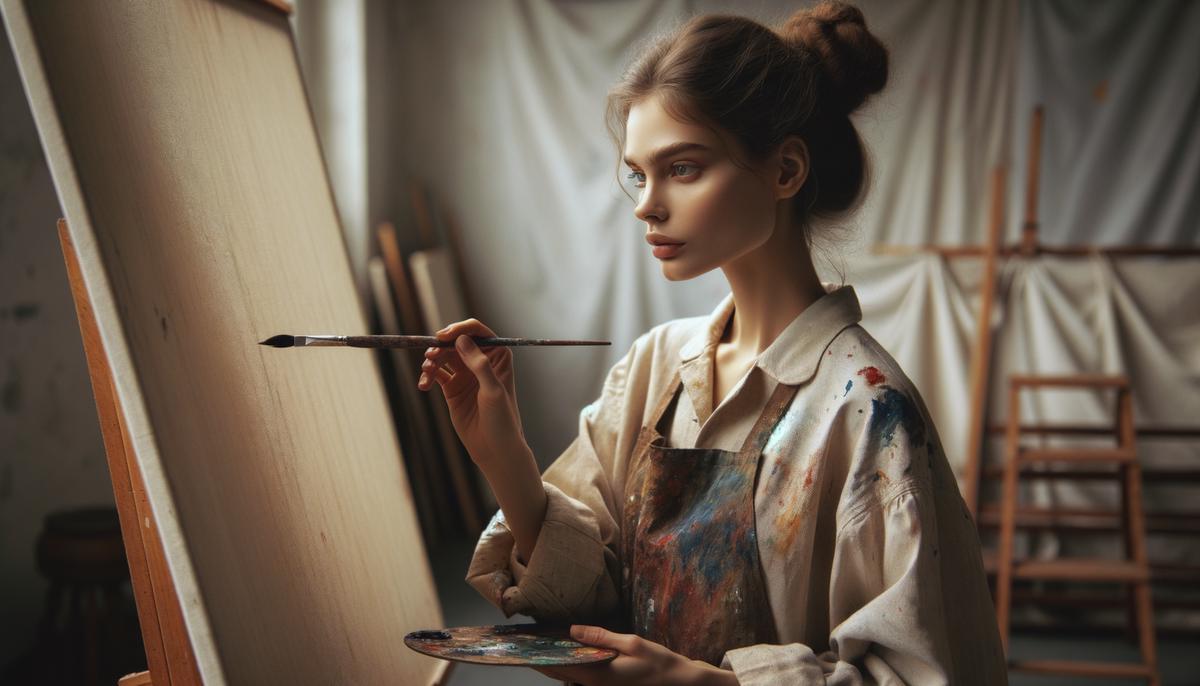
The New York Years: O’Keeffe and Stieglitz
In the unfolding narrative of American modernism, few tales are as intertwined and mutually influential as that of Alfred Stieglitz and Georgia O’Keeffe. Stieglitz, not just a mere photographer but a visionary in the American art scene, played a cardinal role in sculpting the trajectory of O’Keeffe’s career, as well as the very contours of her personal evolution. Their relationship, carved from their initial meeting, ripened into a complex tableau marked by passion, promotion, and profound mutual impact.
Stieglitz first encountered O’Keeffe’s work in 1916, when he came across a series of her charcoal drawings. Captivated by their striking autonomy and distinct voice, he elected to display her work in his 291 gallery without her consent—a bold move that would seed their future relationship. This unsolicited exhibition marks the inception of O’Keeffe’s entry into the pulsating heart of New York’s art scene, anchored by Stieglitz’s influential platform. Their initial correspondence, burgeoning from discussions about art, kindled a connection that transcended mere mentorship or promotion.
As their relationship deepened, it evolved into a multifaceted partnership that interwove their personal and professional lives. O’Keeffe served as Stieglitz’s muse, a role illuminated by the plethora of portraits he snapped of her—over 300 in total—that document not just O’Keeffe’s physical evolution but also a shared journey of artistic exploration. These images, layered with intimacy and introspection, reveal the symbiotic exchange between the two. They launched O’Keeffe into the public eye, her persona enmeshed with her art, making her one of the most photographed women of the 20th century.
Yet, the transaction was not one-sided. O’Keeffe imbued Stieglitz’s work with a fresh reverence for the complex nature of femininity and identity. Her influence permeated his photography, transforming his perspective and, by extension, his oeuvre.
Simultaneously, Stieglitz championed O’Keeffe’s work with an unwavering belief in her capabilities, providing her with the resources and platform to explore and expand her artistry. Through his galleries, particularly 291, Intimate Gallery, and An American Place, Stieglitz offered O’Keeffe a critical exhibition space, unprecedented for a woman artist of her time. His relentless promotion resonated within the echelons of American and international art collectors, curators, and critics, positioning O’Keeffe as a central figure in American Modernism.
The convergent point in their relationship—their marriage in 1924—signaled not just a romantic unification but also a deeper communal engagement with their creative quests. This partnership, however marred by complexities and Stieglitz’s infidelity, prompted shifts in both personal spheres and artistic endeavors. O’Keeffe’s subsequent decision to divide her time between New York and New Mexico encapsulated her search for autonomy away from Stieglitz’s imposing shadow and the artistic ferment of the city.
In New Mexico, O’Keeffe discovered a sanctuary for contemplation and creativity, manifesting in vivid landscapes that distinguished her later work. This transition marked a pivotal divergence in their joint narrative, emphasizing O’Keeffe’s need for an individualistic articulation separate from Stieglitz’s encompassing influence.
In synthesis, the interplay between Alfred Stieglitz and Georgia O’Keeffe underlines a story of mutual inspiration and complex interdependencies. Through Stieglitz’s unwavering promotion of her talent and her protagonistic role in his artistic exploration, they built a shared legacy marked by individual achievements. Their partnership showcases the potent dynamics of artist and muse, partners entwined in a continuous dialogue, each propelling the other into uncharted territories of self-discovery and expression, thereby cementing an indelible mark on the landscape of American modernism.
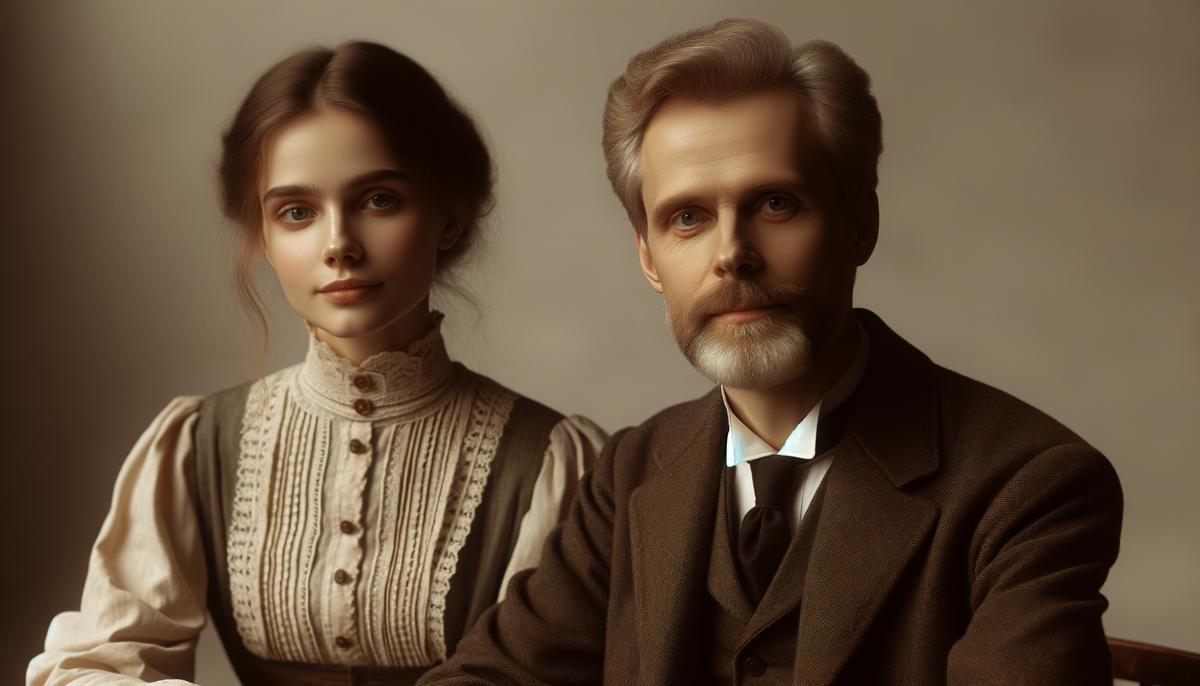
Signature Motifs: Flowers, Bones, and Landscapes
In the heart of Georgia O’Keeffe’s illustrious body of work, the elements of flowers, bones, and landscapes emerge not only as central motifs but as profound symbols capturing the essence of life’s cyclical nature. These symbols intertwine to form a narrative that is both tangible in its realism and elusive in its abstraction, navigating the vast spectrum between life and death, as well as the corporeal and the ethereal.
Flowers, in O’Keeffe’s canvas, are not merely botanical subjects rendered in vibrant hues; they are potent metaphors of existence itself. Known for their magnified depictions that fill the canvas, O’Keeffe’s flowers transcend their mundane appearances to evoke a meditative reflection on nature’s profound yet fragile beauty. They are reminiscent of the fleeting moments of life, captured in the burst of a bloom that, despite its ephemeral glory, leaves an indelible mark on the observer. In the grandeur of these floral depictions, O’Keeffe channels the intensity and intimacy of life’s moments, offering a stark contrast to the prevailing norms of her time that often relegated such natural forms to the periphery of artistic concern.
Conversely, the stark, bleached bones that recur throughout her works stand as silent witnesses to the inevitable end all living creatures meet. Yet, within this contemplation of mortality, O’Keeffe discovers a peculiar beauty. The bones, often set against the vast expanses of the New Mexico desert skies, seem to almost converse with the elements, embodying the ceaseless dialogue between earth and sky. These skeletal forms, stripped of their ephemeral flesh, reach towards something more lasting—an attempt to grasp the ethereal. They symbolize not just death, but a transcendence from earthly confines, acting as a bridge between the tangible world and an abstract, infinite horizon.
The landscapes that cradle these motifs together stitch the fabric of O’Keeffe’s oeuvre into a coherent whole. New Mexico’s desert, with its undulating plains and stark ridges, serves as the embattled arena where life and death, reality and abstraction, engage in their eternal dance. These landscapes are more than mere backdrops; they actively shape and are shaped by the dialogue within O’Keeffe’s art. The land is alive, breathing and whispering secrets through the blooming flowers and silent skulls that pepper its surface. It becomes a metaphor for the inner landscapes O’Keeffe navigates—an exploration of her deepest contemplations on existence.
In essence, flowers, bones, and landscapes in Georgia O’Keeffe’s work collectively embody her profound connection with the natural world. They serve as metaphors for broader themes—life’s transient beauty, the inevitable shadow of mortality, and the ongoing interplay between the physical reality we inhabit and the abstract planes we can only glimpse. Through these motifs, O’Keeffe constructs a visual language that is both deeply personal and universally resonant.
Her art captures not just the American spirit in its rugged individualism and pioneering vision but delves deeper into the fundamental questions of human existence. In this interplay of motifs, O’Keeffe finds the means to convey not only the awe-inspiring beauty of the natural world but also its inherent symphony of life and death. The connection she forges with nature through her work thus reflects not merely an aesthetic appreciation but a philosophical inquiry into life’s profound mysteries. Through her canvas, O’Keeffe invites us to look beyond the surface—to see in the bloom of a flower or the curve of a bone the endless cycle of becoming and fading away that defines our existence.
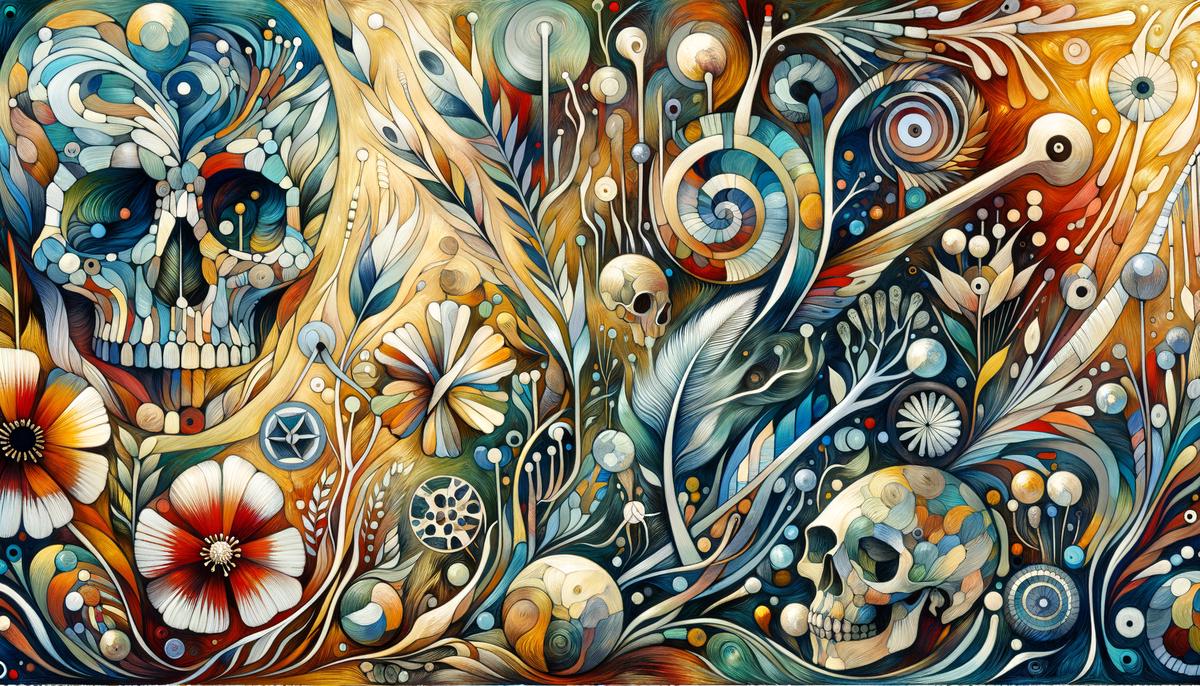
The New Mexico Influence
Georgia O’Keeffe’s journey to New Mexico in 1929 marked a pivotal shift not just in her surroundings but in the essence of her artistry. Departing from the towering skyscrapers and bustling streets of New York, O’Keeffe entered a terrain that was drastically different, both visually and spiritually. New Mexico presented a landscape replete with vast deserts, jagged mountains, and an endless sky that seemed to challenge the very limits of perspective and color. This stark, untamed beauty offered a new canvas for O’Keeffe’s evolving artistic language, prompting a transformative phase in her career.
The profound influence of New Mexico’s culture and landscape on O’Keeffe’s art cannot be overstated. The indigenous cultures of the region, with their deep spiritual connections to the land and a rich history of arts and crafts, provided a fresh lens through which O’Keeffe viewed the world around her. The sun-bleached bones and stark landscapes, so emblematic of her New Mexico period, reflect a clear departure from her earlier works. They delve into themes of mortality and eternity, subjects that the expansive New Mexican desert both embodies and inspires. In the vast silence of the desert, O’Keeffe found the space to reflect, leading her to distill her impressions of the natural world into the powerful, minimalistic representations that have marked her as a pioneer of American Modernism.
O’Keeffe’s move to New Mexico also marked her shift from being not just an observer of nature, but a participant in its lonely, gnarled beauty. The skulls and antlers she began to incorporate into her paintings symbolize a more intimate relationship with the environment, one that acknowledges death and decay as part of life’s cycle. These elements, integrated into her work, underscore a universal balance, translating the temporal aspects of nature into eternal art forms.
Moreover, her immersion into the cultural tapestry of New Mexico allowed O’Keeffe to explore the syncretism between the indigenous aesthetics and her own artistic expression. The adobe architecture, with its organic forms and earthy palette, echoed her affinity for natural shapes and textures, seamlessly blending into her repertoire. The local flora and fauna, too, became subjects of her pieces, translating the vibrancy and resilience of the desert life onto canvas.
It is in New Mexico that O’Keeffe’s art transcended its earlier roots, blossoming into an era where her depictions were not just of landscapes and objects but of the emotions and stories they evoked. The high deserts and mesas, with their shifting lights and shadows, taught her new dimensions of color and form. O’Keeffe’s New Mexico paintings do not merely capture a time or place; they resonate with the profound spirit of the landscape itself—an embodiment of solitude, freedom, and a sacred communion with nature.
The synthesis of O’Keeffe’s direct experiences with the vast and varied landscapes of New Mexico ignited a significant evolution in her work, moving her toward a greater abstraction that stripped away the unnecessary, focusing instead on what was essential, universal, and profoundly true. As a result, her work during this period is not just a mirror to New Mexico’s outer beauty but an exploration into its deep, spiritual essence—one that significantly enriched O’Keeffe’s contributions to American modernism and solidified her legacy as a seminal figure in art history.
This substantial creative evolution mirrored by O’Keeffe’s immersion into New Mexico encapsulates a dialogue between an artist and her environment, illustrating how deeply place can inform and transform artistic vision. Through her eyes and hands, the raw, untamed majesty of New Mexico was morphed into something eternal—a legacy etched into the fabric of American modernism. By weaving together the threads of personal experience with a broader aesthetic exploration, O’Keeffe’s New Mexico period reveals itself as a seminal chapter in her unending quest to capture the sublime essence of existence through art.
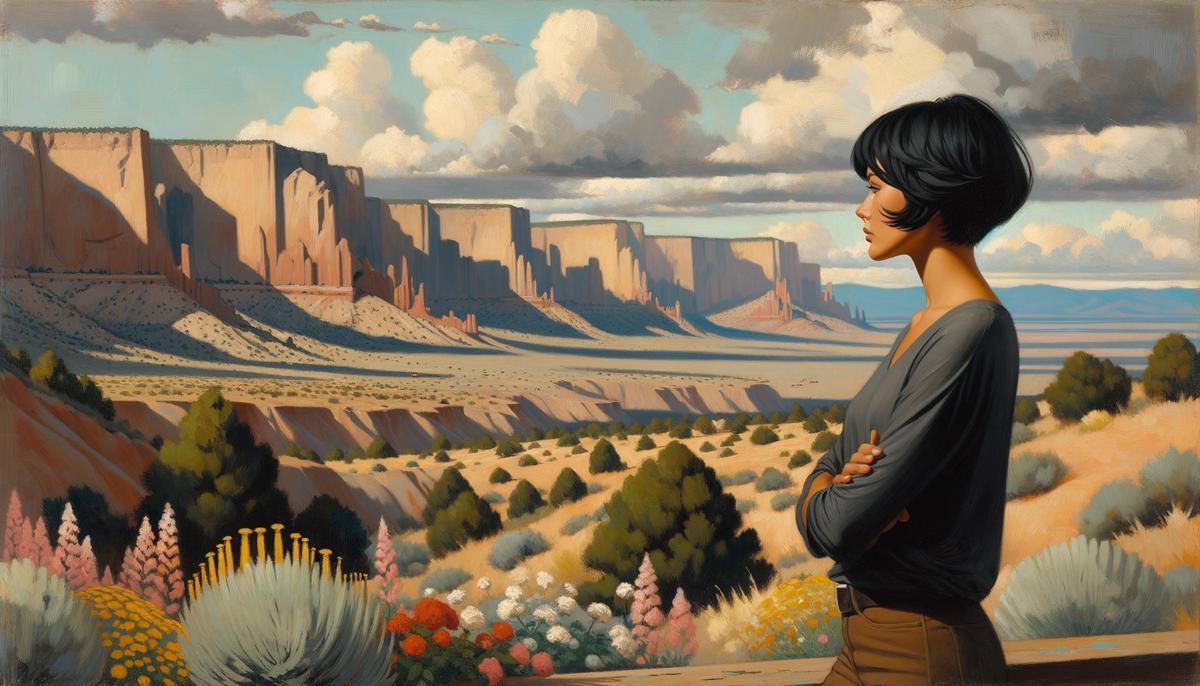
O’Keeffe’s Legacy and Influence
Georgia O’Keeffe’s footprint in the terrain of American modernism is both profound and expansive, asserting her as a colossus in the annals of 20th-century art. Her journey, embodied by shifts between realism and abstraction, not only charted a path for herself but also illuminated routes for those who followed. This evolution of her work, deeply rooted in personal experiences with nature and her intimate realities, continues to resonate, defying temporal boundaries and geographical confines. Beyond her enumeration of natural motifs—flowers turned existential symbols, bones reflective of mortality, and landscapes engaging in silent dialogues—lies a deeper elucidation of O’Keeffe’s intrapersonal explorations, intertwined with the external world.
As O’Keeffe maneuvered through the streams of American modernism, the contours of her identity as a pioneering female artist began to emerge prominently. In an epoch predominantly dominated by male perspectives, her ascendance signified not merely a disruption but a recalibration of artistic hierarchies and gendered expectations within the art world. O’Keeffe’s maneuvering through the confines and biases of her time was analogous to threading a needle in a windswept desert—precise, arduous, yet undeniably transformative. Her association with Alfred Stieglitz, both tumultuous and tender, played a pivotal role in this artistic odyssey, bridging the personal with the universal. Stieglitz’s lens captured O’Keeffe not merely in portraiture but elevated her persona into the realm of allegory—simultaneously a muse and a maverick.
The bequeathment of O’Keeffe’s legacy is multifaceted, spanning the crystalline sands of New Mexico to the global art lexicon. Her indelible mark on subsequent generations crystallizes not through mimicry but rather in the ethos of exploration and boundary-less expression she championed. Modern artists, dancers, photographers, and sculptors alike find solitariness in O’Keeffe’s courage to transcend conventional boundaries and her relentless pursuit of an authentic voice amidst an orchestra of established norms. The echo of this pursuit finds its way into classrooms, galleries, and studios across nations, whispered amidst discussions delving into intersections of art with nature, femininity, and abstraction.
Contemporary discourse around O’Keeffe resists the succumbing to nostalgic reminiscence. Instead, it invigorates ongoing dialogues on the dimensions of human experience—challenging, inspiring, and gearing future generations towards profound inquiries. Her legacy, thus, functions as a bridge—traversing past and present, merging tangible landscapes with ethereal explorations, and catalyzing a perpetual cycle of reflection and reinvention. The trajectory of O’Keeffe’s influence unveils a symbiosis between her expanding visualization of the American landscape and the contouring of modern artistic sensibilities both within and beyond American borders.
In tracing O’Keeffe’s monumental legacy, what resurfaces is an understanding that her contributions extend beyond the canvas—transforming into a resonant philosophical dialogue with the nature of existence itself. From capturing the nuanced gradations of a flower to encapsulating the expansive serenity of the Southwestern terrain, O’Keeffe’s work serves as a testimonial to an artist’s reciprocity with the world. It is in this communique between the self and the non-self where her legacy, permeating temporality, invites a constant reexamination of our interaction with art and the mirrors it holds up to our intricacies.
Her legacy, sewn into the fabric of American modernism and stretching into the tapestry of global art history, delineates O’Keeffe’s profound understanding of life’s fleeting moments and perennial truths. As eminently captured in her work and her myriad expressions within the personal scope, Georgia O’Keeffe transcends being a curator of nature. She emerges as an alchemist—at once transforming and transcending the whisperings of the physical world into a vernacular understood universally. The teachings inferred from her explorations render her not just as an artist frozen in amber by veneration but as a continuously pulsating entity guiding introspection and formative inquiry. The dimensions of Georgia O’Keeffe’s imparted wisdom canvas the broad strokes necessary for engaging with the core of human expressiveness—making her influence inalienable from the vortex of artistic revelation and reformation that perpetually evolves within American modernism and its emanating influences across the global art spectrum.
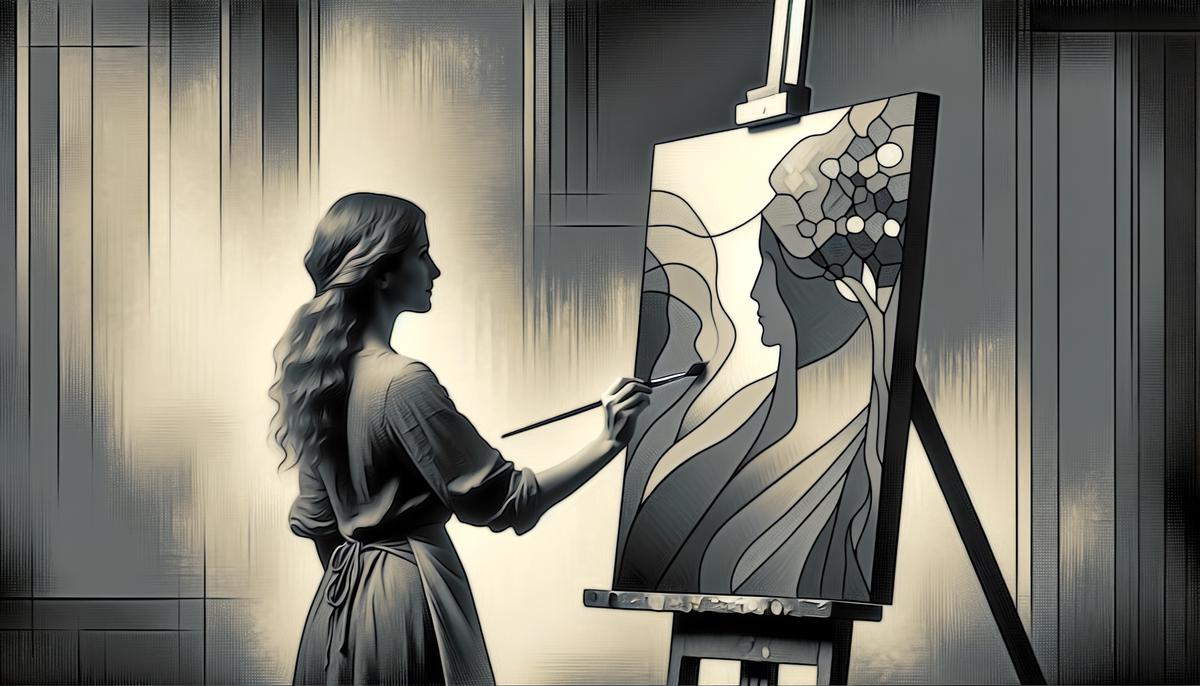
The Technical Aspects of O’Keeffe’s Art
Amidst Georgia O’Keeffe’s exploration of the American landscape and the internal seascape of her existence, her technical prowess stood as a testament to her modernist legacy. Beyond the grand narratives of her life and the poignant symbolism threaded into her art, it’s O’Keeffe’s technical innovations that propelled her into the modernist pantheon. Specifically, her nuanced application of color, innovative composition frameworks, and unswerving commitment to abstraction marked a significant deviance from the prevailing norms and pushed the boundaries of American art during her era.
O’Keeffe’s foray into color was not merely a choice; it was a manifesto. Rejecting the muted palettes that dominated the works of her contemporaries, O’Keeffe plunged into the spectrum with voracity. Her colors spoke narratives — from the desolate whites and haunting blues that evoked the visceral desolation of a weathered skull in the desert to the incendiary reds and delicate pinks capturing the transient beauty of a blooming flower. Each hue on her canvas was a character, not merely an aesthetic afterthought but a deliberate beacon guiding viewers into deeper introspection. This wasn’t just art; it was visual poetry.
Equally transformative was O’Keeffe’s approach to composition. She defied traditional perspectives and scales, inviting viewers to encounter subjects as if through a magnifying lens. Flowers weren’t merely flora; under O’Keeffe’s gaze, they became intricate landscapes unto themselves, commanding attention and challenging perceptions. Her paintings made the familiar unfamiliar, reconfiguring mundane vistas into profound statements on essence and existence. It was this audacious manipulation of scale and perspective that distilled the complexity of her subjects into singular, mesmerizing visions, epitomizing modernism’s aim to see the world anew.
Abstraction, however, remains central to understanding O’Keeffe’s technical mastery. From her earliest days, she exhibited a boldness to abstract, to strip away the non-essential and dial into the core of her subjects. Through abstraction, O’Keeffe’s work transcended mere representation; it became an exploration of emotive and spiritual synergies. Whether interpreting the starkness of the southwestern landscape or delving into the metaphysical through floral studies, she leveraged abstraction to bridge the personal and universal, laying bare the undercurrents of shared human experience.
As O’Keeffe’s practice evolved, so did the sophistication of her techniques. Her early work indicates a tentativeness with abstraction, a dance around the edges of what could be said without words. Yet, as time unfurled, her boldness crescendoed. She simplified forms to their elemental lines and shapes, deploying color and composition with ever-greater audacity. Each piece became a distillation of her ongoing dialogue with nature, essence, and the intangible. This evolution—from cautious exploration to full embrace of abstraction—underscores her role as a pioneer in American modernism, challenging and redefining artistic boundaries.
O’Keeffe’s technical virtuosity was more than a showcase of her individual genius; it was a catalyst for change in American art. Her unapologetic embrace of color spoke to a broader desire for expressive freedom. Her revolutionary compositions opened new horizons for visual storytelling, and her fearless journey into abstraction inspired generations of artists to pursue authentic expression beyond the literal. In exploring the vocabulary of her technique, one uncovers not just the hows but the whys of her storied career. It reveals O’Keeffe not merely as a conduit of modernist aesthetics but as an architect of a new paradigm, one where the visceral intertwines with the visual, ushering viewers into lingering contemplations on beauty, transience, and the profound simplicity of existence.
What distinguished O’Keeffe was not solely her luminary status or her defiance of societal constraints; it was her unyielding dedication to probing the capabilities of paint, canvas, and imagination to navigate the chasm between seen and unseen, between the palpable world and its ephemeral echoes. In charting her trajectory, it becomes evident that O’Keeffe’s legacy is intricately woven not just into the fabric of American art but into the very pursuit of modernism itself — a testament to her relentless reinvention of perceptual reality through a confluence of color, composition, and abstraction.
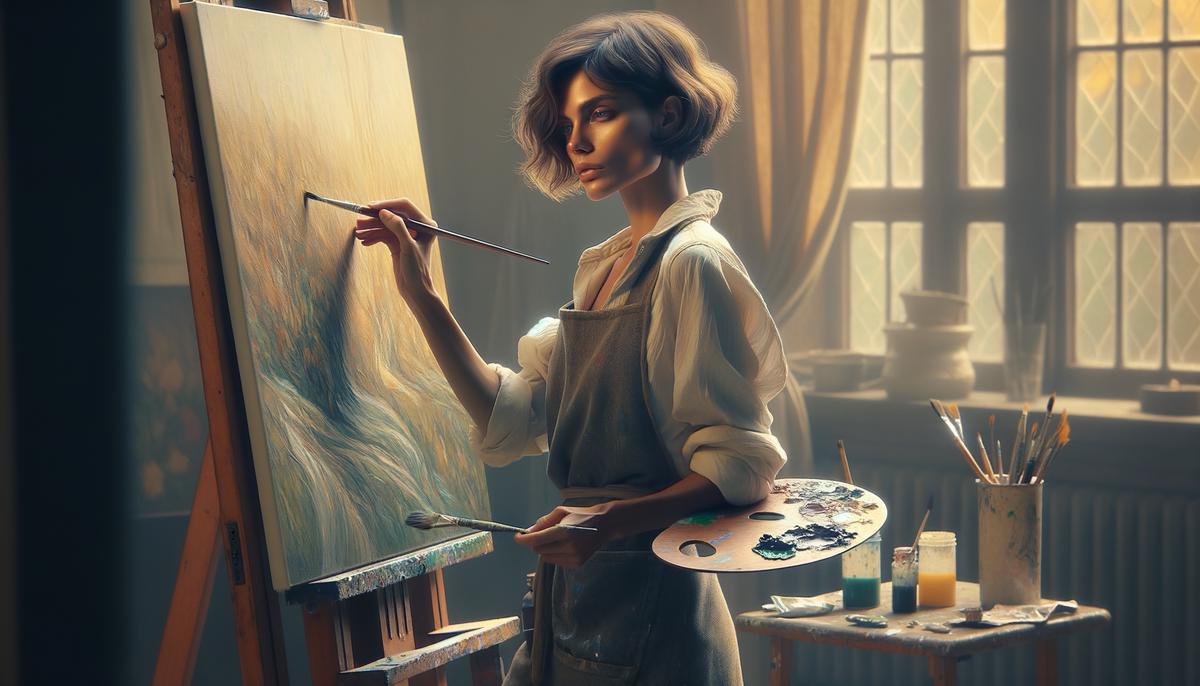
Controversies and Misinterpretations
Georgia O’Keeffe’s paintings, particularly her flower series, remain a cornerstone of American modernism, illustrating her unparalleled knack for fusing the tangible with the mystical. Her work, recurrently scrutinized through a reductive lens framing these florets as blatant representations of female anatomy, wades into the complex waters of controversy and misinterpretation that have, to a large extent, overshadowed the intrinsic values and intentions behind her art.
Despite catapulting O’Keeffe to prominence within the high echelons of American art, this sexualized reading of her flower paintings collided head-on with O’Keeffe’s perception of her own work. Striving to capture the beauty and singular essence of her floral subjects, O’Keeffe’s approach leaned more toward an immersive observation rather than an allegorical exposition of femininity or sexuality. She aimed to pull the viewer into the heart of the flower, urging them to explore its layers, textures, and colors as if witnessing nature’s grand design at a magnified scale.
The magnetism towards sexual interpretations was not just the viewer’s making but was aggrandized by critics and art supporters alike, who, in their bid to navigate the uncharted territories of American modernism, perhaps sought to anchor their interpretations in something both provocative and personally uncharted. Alfred Stieglitz, O’Keeffe’s husband and foremost promoter, played no small part in framing her work within this narrative. His consistent showcasing of O’Keeffe—as both subject and artist—through a sensually charged lens amplified the sexual read into an almost inescapable echo chamber surrounding her work.
In response to these interpretations, O’Keeffe often expressed frustration and disdain. Distancing herself from these imposed narratives, she articulated time and again that her intention was never to create art as a direct reflection of femininity or eroticism but rather as an expression of the wonderments ensconced in the natural world. Her endeavor to strip away the layers, rendering visible the unnoticed beauty and underlying structures of her subjects, was regularly eclipsed by a public and critical reception preoccupied with finding innuendos where there were none intended.
Over the decades, this prevalently sexualized perspective of O’Keeffe’s work has fueled debates and discussions, branching out into larger questions about femininity in art, the autonomy over one’s own narrative, and the intersection between an artist’s intended meaning and the public’s reception thereof. These controversies and misinterpretations, while detracting from O’Keeffe’s intended dialogues through her art, have indelibly shaped the discourse surrounding her oeuvre, pressing art critics, historians, and enthusiasts to reassess not just the lens through which they view O’Keeffe’s work but the broader vista of art interpretation itself.
Yet, despite this turbulent interception by external perceptions, O’Keeffe’s legacy once stripped of these impositions reveals an enduring testament to transformation, perception, and natural beauty. Hers was a pursuit that transgressed the superficial to tap into the elemental essence of life. The wisdom of color, form, and rhythm in her work bares the conversation she held with nature—a dialogue free of predetermined narratives or societal imprints. Through the meticulously crafted petals and nuanced hues awaiting within each frame, O’Keeffe challenges us to eschew preconceived notions and dive into the unspoken serenity and profundity encased in the simple splendor of the flower.
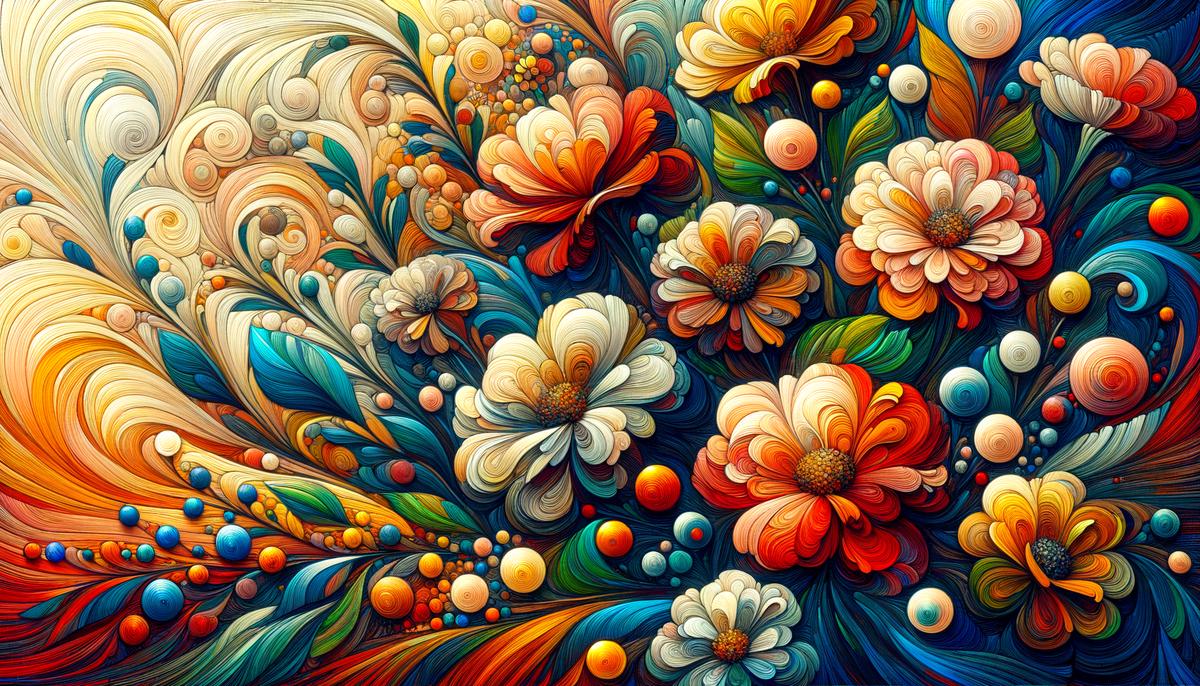
Georgia O’Keeffe’s contribution to American modernism transcends mere visual aesthetics; it is a dialogue with nature and existence itself. Her work invites us to explore beyond the surface, urging a deeper appreciation for the intricate dance between life’s beauty and its ephemeral nature. As we reflect on O’Keeffe’s artistic legacy, we are reminded of the power of art to connect us more profoundly with our surroundings and ourselves. It is this enduring connection that cements Georgia O’Keeffe’s place not just in art history but in our collective imagination as well.























